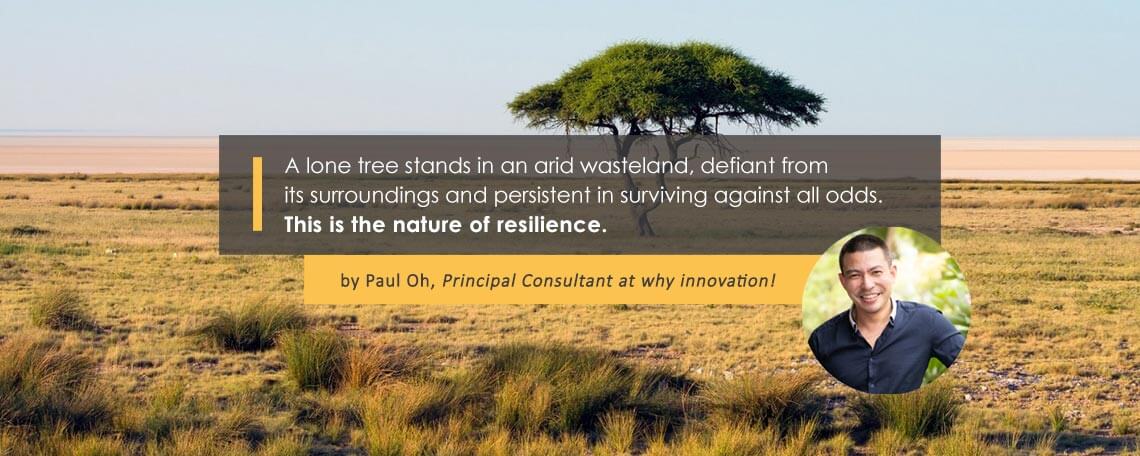A lone tree stands in an arid wasteland, defiant from its surroundings and persistent in surviving against all odds. This is the nature of resilience. The ability to bounce back from adverse events and persevere to not only survive, but to thrive.
In an organisational context, it has become imperative for leaders to guide their teams in moving quickly through the learn-build-measure cycle in order to adapt to the market. Employee resilience could hold the key to sustaining the steady pace of change, a critical factor in organisations wanting to increase the likelihood of success in driving Agile transformations.
In an organisational context, it has become imperative for leaders to guide their teams in moving quickly through the learn-build-measure cycle in order to adapt to the market. Employee resilience could hold the key to sustaining the steady pace of change, a critical factor in organisations wanting to increase the likelihood of success in driving Agile transformations.
At the recent Business Agility conference in Hong Kong, one of the topics of the “deep dive” conversations centred around the acceptance of failure. Whilst failures are generally accepted as part of ‘start-up’ DNA, for large corporations it was a harder pill to swallow due to stakeholder expectations, internal policies and regulatory constraints.
As such, adoption of Agile remains to be a challenging task for larger organisations, where workplace culture (52% of respondents) and resistance to change (48%) continue to be cited as one of the top reasons, according to the 13th State of Agile Report. Examples of this can be seen in organisations when the methodology is used as the reason for project failure and collaboration to resolve dependencies is arduous. |
However, whilst hundreds of models exist, organisational culture can be nebulous. The nature of resilience offers an opportunity to accelerate and sustain Agile transformations. By leveraging an understanding of resilience, we can create a culture more open to transformation. However, this requires shifting the focus towards people, rather than frameworks.
Accelerating and sustaining change
In our recent article on Challenging Change, I referred to the trend of change becoming more frequent. How we think about change is also moving, with transformations no longer being fixed and anchored towards a single point-in-time, but instead flexible and continuous in order to manage greater levels of uncertainty and market dynamics. As a result, employees can be left feeling demotivated and become less engaged over time.
Catalysing change is therefore not the problem - it is more about accelerating and sustaining transformations. To do so, improving the openness for change can help reduce resistance and improve active collaboration.
This is where resilience is key.
Understanding resilience
Resilience, the ability and flexibility to cope with adversity, can be described using several lenses:
Accelerating and sustaining change
In our recent article on Challenging Change, I referred to the trend of change becoming more frequent. How we think about change is also moving, with transformations no longer being fixed and anchored towards a single point-in-time, but instead flexible and continuous in order to manage greater levels of uncertainty and market dynamics. As a result, employees can be left feeling demotivated and become less engaged over time.
Catalysing change is therefore not the problem - it is more about accelerating and sustaining transformations. To do so, improving the openness for change can help reduce resistance and improve active collaboration.
This is where resilience is key.
Understanding resilience
Resilience, the ability and flexibility to cope with adversity, can be described using several lenses:
- Organisational – the ability for an organisation to anticipate, prepare and respond to adverse events.
- Systems – the ability of a system to withstand major disruption.
- Design – the intentional design of a product to reduce vulnerabilities.
- Community – the sustained ability of a community to utilise resources to withstand adverse events.
- Individual – the behaviours, thoughts and actions that allow a person recover from stress and adversity.
Given Agile is human-centred, we will focus on the resilience of individuals or teams. This is because empirical studies have shown that an individual with a higher level of psychological capital, where resilience is the strongest indicator, is more likely to be engaged in the workplace and be more adaptive to change. |
Furthermore, resilience is currently understood to be an area of personal development which is malleable or able to be positively influenced by interventions such as training, coaching and daily practice.
Alignment between Resilience and Agile
Wagnild, who developed the oldest resilience scale in 1993 and subsequently in 2009, describes the five domains of resilience as purpose, perseverance, self-reliance, equanimity (composure), and authenticity. Below is how each domain strongly aligns to the Agile manifesto and principles:
1. Purpose
“Highest priority is to satisfy… through early and continuous delivery”
Having a purpose is what motivates all of us to continue forward, providing meaning to the work we do and actively engaging. Ensuring the continuous delivery of working software, requires a sense of purpose which is often articulated as a product vision or within sprint goals. Having a vision can provide extrinsic motivation to pursue the best designs, architecture or quality of code.
In certain circumstances, the vision or goals may not be clear and can be difficult to relate to a single work item. As such, being able to intrinsically source and harness a sense of purpose becomes more important, especially as a self-organising team.
Wagnild, who developed the oldest resilience scale in 1993 and subsequently in 2009, describes the five domains of resilience as purpose, perseverance, self-reliance, equanimity (composure), and authenticity. Below is how each domain strongly aligns to the Agile manifesto and principles:
1. Purpose
“Highest priority is to satisfy… through early and continuous delivery”
Having a purpose is what motivates all of us to continue forward, providing meaning to the work we do and actively engaging. Ensuring the continuous delivery of working software, requires a sense of purpose which is often articulated as a product vision or within sprint goals. Having a vision can provide extrinsic motivation to pursue the best designs, architecture or quality of code.
In certain circumstances, the vision or goals may not be clear and can be difficult to relate to a single work item. As such, being able to intrinsically source and harness a sense of purpose becomes more important, especially as a self-organising team.
Whilst Agile provides a methodology for dealing with uncertainty, our ability to keep going and respond to change is core to its manifesto. Perseverance enables teams to continuously deliver at a steady pace, addressing impediments or setbacks, and continuing to move forward. The pursuit of excellence is rarely a once off. Transformations can be relentless as a shared understanding between businesses, technology teams, customers and users are continuously sought.
3. Composure
Sustainable pace” and “reflection”
In transformations, this is where maintaining composure in the business can also be of benefit. Our ability to remain calm in difficult situations relies on being able to maintain a balanced view of life, work and the world around us. By doing so, we can moderate the extreme responses to adverse events or changes. In Agile coaching, this is often useful when reframing problems or facilitating conflict resolution. In addition, composure allows us to understand perspectives, empathise with customers, accept late changes, and sustain a steady pace.
4. Self-reliance
"Self-organising teams”
Believing in one’s self in order to support the wider team, is another ideal characteristic of resilience for self-organising teams. Being able to know one’s self, recognising strengths and drawing on past successes, can be a powerful aid in creating high-performing Agile teams. This awareness can assist greatly in the daily interactions between business and developers, as well as contribute to an environment which is encapsulated by servant-leadership.
5. Authenticity
"Reflection and motivation”
Whilst some experiences are shared, some challenges need to be faced alone. This is where being authentic to yourself and your values should be unwavering. In the workplace, however, this can sometimes be challenging. For example, being directed to complete a task which may involve confrontation or in some cultures, a greater sense of duty to hierarchy. Agile places great value in the interactions and collaboration with others. For this to truly be effective, being authentic is crucial in these conversations. For example, being able to openly disclose areas outside of your strengths in sprint planning or being able to contribute constructively towards self-organisation.
Sustainable pace” and “reflection”
In transformations, this is where maintaining composure in the business can also be of benefit. Our ability to remain calm in difficult situations relies on being able to maintain a balanced view of life, work and the world around us. By doing so, we can moderate the extreme responses to adverse events or changes. In Agile coaching, this is often useful when reframing problems or facilitating conflict resolution. In addition, composure allows us to understand perspectives, empathise with customers, accept late changes, and sustain a steady pace.
4. Self-reliance
"Self-organising teams”
Believing in one’s self in order to support the wider team, is another ideal characteristic of resilience for self-organising teams. Being able to know one’s self, recognising strengths and drawing on past successes, can be a powerful aid in creating high-performing Agile teams. This awareness can assist greatly in the daily interactions between business and developers, as well as contribute to an environment which is encapsulated by servant-leadership.
5. Authenticity
"Reflection and motivation”
Whilst some experiences are shared, some challenges need to be faced alone. This is where being authentic to yourself and your values should be unwavering. In the workplace, however, this can sometimes be challenging. For example, being directed to complete a task which may involve confrontation or in some cultures, a greater sense of duty to hierarchy. Agile places great value in the interactions and collaboration with others. For this to truly be effective, being authentic is crucial in these conversations. For example, being able to openly disclose areas outside of your strengths in sprint planning or being able to contribute constructively towards self-organisation.
1. Assess and build competence
2. Reflect and bounce back
Resilience as a foundation
In the several organisations I’ve been involved with, Agile transformations have primarily focussed on the implementation of a framework - through training, systems and organisational structures. It is rare for organisations to build a higher level of competency and awareness that allow for its employees to be ready before the “roll out” of the change. In the case of Agile transformations, change readiness is even more important as it can often be at odds with existing operations that have a long history. This is where a greater level of resilience can pave the way for an accelerated and sustainable transformation.
- Empirically measure the competency area of resiliency – purpose, perseverance, composure, self-reliance and authenticity
- Create awareness and a common language around resilience
- Build resources within teams (different daily practices, knowledge base of articles and books, support networks of mentors and coaches)
- Incorporate resilient practices into ceremonies (e.g. “Three Good Things” as part of Daily Scrum, reframing exercises as part of Backlog Refinement, “Chaos Monkey” for tech teams)
- Coach Agile teams to behave more as a support network beyond product delivery
- Integrate resilience training (courses or exercises) into Agile transformation initiatives (for leaders, middle management and teams)
- Increase emotional intelligence within the team through increased focused on soft skills development (e.g. coaching, mentoring, and cognitive bias training)
2. Reflect and bounce back
- Ask powerful coaching questions such as “what did we learn about each other?”
- Reflect on how adverse events were handled during sprints
- Incorporate resilience practice (e.g. reframing or controlled dissent activities) within retrospectives
- Provide individual coaching to embed resilience training as part of daily practice
- Actively reinforce practices to maintain balance, seek perspectives, reframe problems
- Don’t forget to celebrate successes and turnarounds
Resilience as a foundation
In the several organisations I’ve been involved with, Agile transformations have primarily focussed on the implementation of a framework - through training, systems and organisational structures. It is rare for organisations to build a higher level of competency and awareness that allow for its employees to be ready before the “roll out” of the change. In the case of Agile transformations, change readiness is even more important as it can often be at odds with existing operations that have a long history. This is where a greater level of resilience can pave the way for an accelerated and sustainable transformation.













